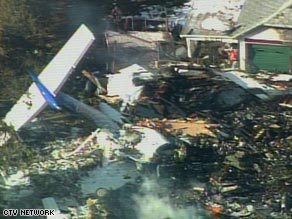
Trailing what would become a fatal flight by some 27 minutes, the same kind of aircraft operated by the same airline traveled the same route last week and landed safely, the NTSB said Monday.
The pilot of the second Continental Connection flight from Newark, New Jersey, to Buffalo, New York, reported “moderate icing” during the trip and “made it to destination in Buffalo,” said Steve Chealander of the National Transportation Safety Board. The second plane was a Bombardier Dash 8 Q400, like the plane that crashed Thursday night near the Buffalo airport, killing 49 people on board and one person on the ground. Also like the fatal flight, the aircraft was operated on the Continental Connection route by Colgan Air, Chealander said. Possible icing — and how the aircraft and the flight crew performed if icing was an issue — has become a focus in the aftermath of the crash of Flight 3407. The pilot and first officer of the flight discussed “significant” ice buildup on the aircraft’s windshield and wings before the crash, the NTSB said after listening to the cockpit voice recorder. Chealander said Monday that he had been asked about possible icing on the aircraft’s tail. “If there’s icing on the wings, there’s icing on the tail,” he said. “The significance of that is yet to be determined.” The flight data recorder indicated the plane’s deicing system was activated 11 minutes after takeoff from Newark and remained on until the crash, according to the NTSB. Chealander said investigators have recovered most of the pieces of that system and will examine those materials to determine whether the system was operating properly.
Don’t Miss
NTSB: Plane rolled violently before crash
‘Everybody loved being around her’
Would-be passengers feel relief, sadness
Witnesses saw and heard plane going down
Chealander also said questionnaires were being sent to every pilot who flew in the Buffalo vicinity the night of the crash to find out what icing conditions they might have encountered. He said the only report to air traffic controllers of “severe” icing that night came from a pilot “well south of the Buffalo area.” On Sunday, Chealander gave details of the final violent seconds of the flight, saying the flight data recorder indicated that in the final seconds, the plane’s nose pitched drastically up, then down, and the plane then rolled left 46 degrees and then right 105 degrees, or past the 90-degree vertical point. Before impact in a residential neighborhood, the plane fell 800 feet in five seconds, Chealander said. On Monday, he said about half the aircraft wreckage had been removed from the crash site and taken for detailed examination. Giving an indication of the explosive nature of the impact and subsequent fire, Chealander said wreckage is being taken away “in bins and on trailers.”
He said investigators hope to have all wreckage removed from the crash site by Wednesday, when a snowstorm is forecast for the area. Authorities have not discussed the status of the removal of victims’ remains since Saturday night, when they said 15 bodies had been recovered.